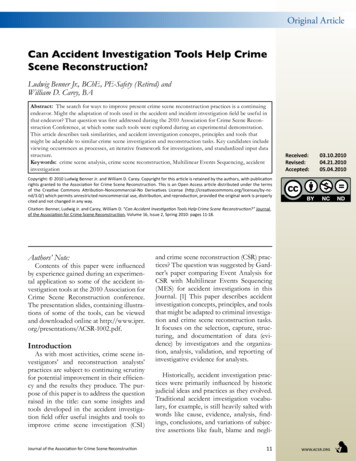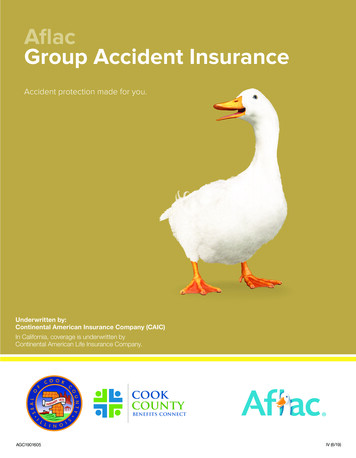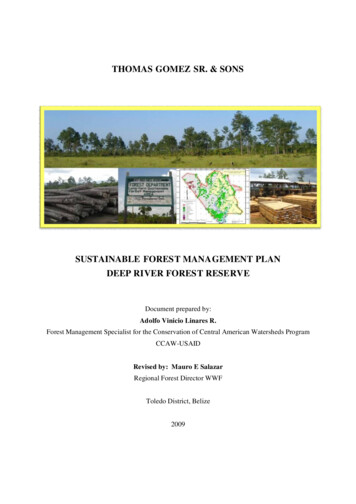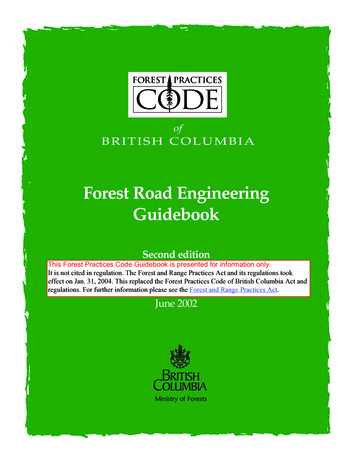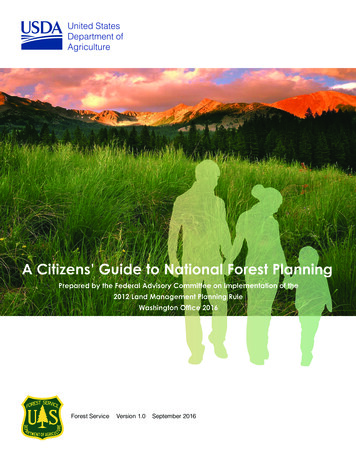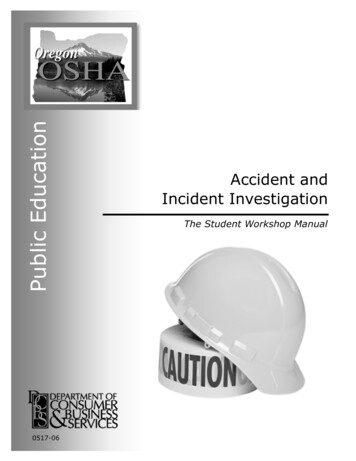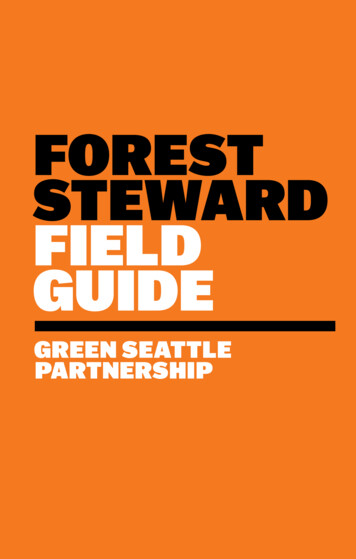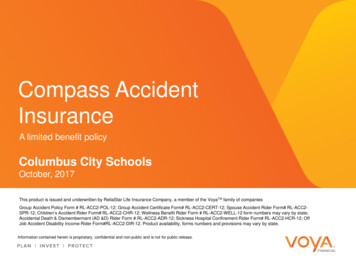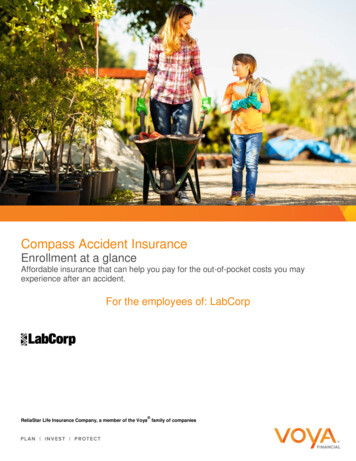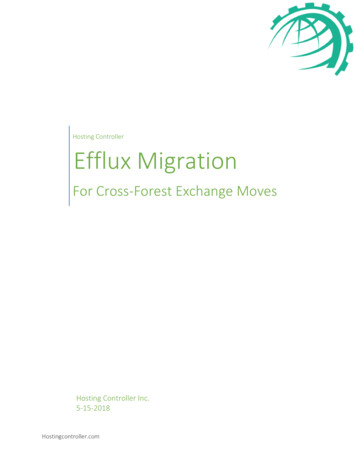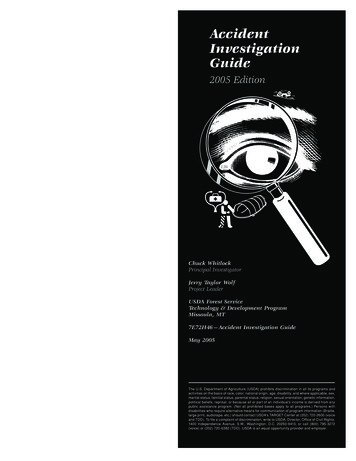
Transcription
AccidentInvestigationGuide2005 EditionChuck WhitlockPrincipal InvestigatorJerry Taylor WolfProject LeaderUSDA Forest ServiceTechnology & Development ProgramMissoula, MT7E72H46—Accident Investigation GuideMay 2005The U.S. Department of Agriculture (USDA) prohibits discrimination in all its programs andactivities on the basis of race, color, national origin, age, disability, and where applicable, sex,marital status, familial status, parental status, religion, sexual orientation, genetic information,political beliefs, reprisal, or because all or part of an individual’s income is derived from anypublic assistance program. (Not all prohibited bases apply to all programs.) Persons withdisabilities who require alternative means for communication of program information (Braille,large print, audiotape, etc.) should contact USDA’s TARGET Center at (202) 720-2600 (voiceand TDD). To file a complaint of discrimination, write to USDA, Director, Office of Civil Rights,1400 Independence Avenue, S.W., Washington, D.C. 20250-9410, or call (800) 795-3272(voice) or (202) 720-6382 (TDD). USDA is an equal opportunity provider and employer.i
AcknowledgmentsProject leader Jerry Taylor Wolf wishes to thank the following peoplefor their contributions to this project:Bill Bulger, aviation safety manager (retired)Ann Baker, safety managerNorthern RegionBarb Hall, aviation safety specialistGeorge Jackson, special assistantWashington Office, Fire and AviationGreg Nichols, assistant director (retired)Dick Mangan, fire program leader (retired)Ann Melle, assistant directorWashington Office, Office of Law Enforcement and InvestigationsMissoula Technology and Development CenterDick King, directorWashington Office, Office of Safety and Occupational HealthGary Hoshide, safety and health and recreation program leaderAcknowledgmentsMissoula Technology and Development CenteriiPacific Northwest RegionWashington OfficeWashington Office, Office of Law Enforcement and InvestigationsSara Lustgraaf, visual information specialistMissoula Technology and Development CenterThanks to everyone who reviewed the draft and provided informationfor the final document.
ContentsChapter 1—Accident Investigation 11.1 Introduction 21.2 Authority 21.3 Purpose 21.4 Scope 21.5 Investigation Team Selection 31.6 Composition of the Investigation Team 31.7 Investigation Sequence 61.8 Investigation Briefings and Report 71.9 Report Use 8Chapter 2—Investigation Overview 332.1 Introduction 342.2 Accident Sequence 342.3 Human Factors Accident and Incident Analysis 342.4 Equipment Factors Analysis 352.5 Environmental Factors Analysis 35Chapter 3—Witness Statements and Interviews 43Chapter 4—Physical and Photographic Evidence 514.1 Physical Evidence—General 524.2 Physical Evidence Preservation and Collection 524.3 Types of Physical Evidence 524.4 Photographic Evidence–General 524.5 Photographic Documentation 53Chapter 5—Guidelines for Establishing Findings, Identifying Causal Factors andContributing Factors, and Developing Recommendations 575.1 Establishing Findings 585.2 Identifying Causal Factors 585.3 Identifying Contributing Factors 595.4 Developing Recommendations 59Chapter 6—The Investigation Report: Factual and Management Evaluation Sections 616.1 General 626.2 Distribution of the Report 63Chapter 7—Accident Review Board 677.1 Purpose 687.2 Composition of the Accident Review Board 687.3 Duties and Responsibilities 687.4 Convening the Accident Review Board 687.5 Final Approval of the Accident Prevention Action Plan and Distribution of the Report 697.6 Disposition of the Report and the Case File 697.7 Release of the Accident Investigation Report and Documents 707.8 Briefings, Press Releases, Family Meetings 70iiiContents3.1 General 443.2 Statements 443.3 Interviews 443.4 Conducting the Interview 443.5 Types of Questions 453.6 Sample Witness Interview Questions 45
Chapter 8—Wildland Fire Shelter Entrapments, Deployments, and Fatalities 758.1 General 768.2 Scope and Purpose 768.3 Wildland Fire Shelter Entrapments, Deployments, and Fatalities Protocol 76Chapter 9—Aviation Investigations 839.1 Introduction 849.2 Scope and Purpose 849.3 National Transportation Safety Board Investigations 849.4 Forest Service Investigations 849.5 Composition of the Investigation Team 859.6 Forest Service Accident Investigation Report 859.7 Aviation Investigation Sequence 85ContentsGlossary and Abbreviations Used in Investigations 103iv
ChapterAccident Investigationv
Chapter 1—Accident Investigation1.1 IntroductionA Forest Service serious accident is one that involves: A death Three or more persons hospitalized after treatment forreasons other than observation Wildland fire shelter deployments or entrapments Property damage, other than to aircraft, that exceeds 250,000 Damage to aircraft that exceeds 1,000,000 or results intotal destruction of the aircraftA. Supervisors and managers at all organizational levels areresponsible for identifying and abating hazards, incorporatingsafe operating procedures into each of our daily tasks, andrefusing to accept unnecessary risk. The causes of mostaccidents or incidents are a result of failures to observeestablished policies, procedures, and controls. All too often,accident investigations reveal existing hazards that were notadequately addressed.1.11.21.31.4B. The accident investigation gathers and interprets informationto help managers understand how and why an accident orincident occurred. Recommendations can then be developedfor corrective actions that will mitigate hazards and preventfuture injuries and property damage.C. An investigation must be done promptly to assure thatimportant information is not lost, misplaced, or contaminated.The agency’s first priority is to aid the injured and to ensureprompt emergency medical attention. As soon as the emergency situation is over, the accident investigation begins.D. An accident is an unplanned event involving Forest Serviceemployees, volunteers, cooperators, contractors, emergencyfirefighters, special program enrollees, property, or theenvironment that results in an injury, illness, or material loss(chapter 6732.1 of FSM 6700).E. An aviation accident is an occurrence associated with theoperation of an aircraft that takes place between the time anyperson boards an aircraft with the intention of flight until allsuch persons have disembarked or before equipment hasbeen unloaded.1.2 AuthorityThe authority for the investigation of accidents is establishedin: Public Law 107–203 Title 5, USC 7902 29 CFR 1904.2 41 CFR 101-37 49 CFR 830 NTSB2 Executive Order 12196 FSM 5700, Aviation Management, Chapter 5720 FSM 6700, Safety and Health Program, Chapter 6732.11.3 PurposeThe purpose of accident investigations is to provide management with information for accident prevention. The AccidentInvestigation Guide details information on the investigativeprocess and associated tasks, such as gathering and maintaining custody of physical and photographic evidence,documenting witness statements, interviewing witnesses,managing records, preparing the investigation report (factualand management evaluation sections), and conductingaccident review boards. The guide also includes the investigation protocol for wildland fire shelter entrapments, deployments,and fatalities, and aviation accidents and incidents with potential.Because the guide is revised as needed, it is important to usethe most current version.A compact disk (CD) also is included with the guide. All exhibitsthat may be necessary for accident investigation teams andaccident review boards are provided as Microsoft Word documents.1.4 ScopeA. The Accident Investigation Guide is designed for WashingtonOffice Forest Service Chief’s investigation teams, but regionand station investigations should also follow the guide forconsistency. A Chief’s investigation team may also be mobilizedanytime the Designated Agency Safety and Health Official(DASHO) believes an investigation is warranted, for example,an “incident with potential.”The DASHO may also delegate responsibility to conduct theinvestigation to the regional forester or station director in theregion where the accident occurred. In these cases, the DASHOwill provide a letter of delegation of authority assigning theresponsibility. In these situations, the DASHO may appoint atleast one member to the investigation team. The proceduresoutlined in this guide will be used to conduct delegatedinvestigations.The process in the guide should also be used—entirely or inpart—for all accident and incident investigations conducted atany unit level by individuals working under the direction andauthority of the Forest Service. For example, while specificrequired procedures for motor vehicle accident investigationsare outlined in the Manual on Uniform Traffic Control Devices,applicable information on conducting witness interviews andcollecting evidence is available in this guide.
Chapter 1—Accident InvestigationB. Multi-agency/Interagency Investigations. With the advent ofAll-Hazards Incident Management, Forest Service employees,equipment, and contract resources are now working in unfamiliar environments, such as hurricanes, floods, and biologicalhazard areas, in addition to wildland firefighting. Nationalemergencies may be longlasting events that may require rotation of personnel and other resources. Many of these incidentsalso involve other Federal, State, county and municipalagencies. When accidents occur during these activities, it willbe necessary to conduct multi-agency investigations wherecooperation between agencies is paramount.The team leader should establish cooperative relationshipswith the other agencies involved in the investigation to ensurethat the Forest Service meets its responsibilities while recognizing each agency’s need to fulfill theirs. This may involvenegotiations, cooperative agreements, and coordination withthe agency official who signed the delegation of authority, forexample, a Memorandum of Understanding between the U.S.Department of the Interior (USDI) and the U.S. Departmentof Agriculture (USDA), to establish the basis for interagencyinvestigations of serious fire-related accidents (exhibit 8–3).During these types of investigations, a broader range oftechnical specialists than is typically used in Forest Serviceactivities may be needed to assess risks to involved personnelor to provide the skill level needed to conduct the investigations.C. A Forest Service firefighter fatality as a result of a burnoveror entrapment requires the USDA Office of Inspector Generalto conduct an independent investigation. That investigationshall be independent of the Forest Service investigation(Public Law 107–203).D. Aviation accidents and incidents with potential (mishaps)are investigated in accordance with chapter 9 and FSM 5700,chapter 5720. Smokejumping and helicopter rappelling areconsidered Forest Service aviation accidents if they occurbefore the employee has safely disembarked from the aircraftor before equipment has been unloaded.E. The National Transportation Safety Board (NTSB) has theresponsibility to investigate all Forest Service aviation accidentsand certain incidents with potential (mishaps). This results inspecial interagency working relationships, policies, andprocedures when conducting aviation accident investigations.The NTSB will appoint an investigator in charge (IIC) to performthe NTSB factual investigation. The investigation process anddirection is under the authority of the IIC. The IIC will conductthe NTSB investigation in one of the following ways: The IIC delegates the onsite investigation to the FederalAviation Administration (FAA). When the FAA conducts theonsite investigation, they do so with the full authority of theNTSB. The QTI will be the liaison with the FAA onsiteinvestigator and the Forest Service. The IIC delegates the onsite investigation to the ForestService. When neither the NTSB nor the FAA conductthe onsite investigation, the QTI will conduct the onsiteinvestigation and provide all data collected to the IIC.In addition, the Forest Service investigation team will conducttheir investigation of Forest Service management and policyissues following this investigation guide concurrent with theNTSB investigation.F. Collateral Investigations. Collateral investigations are conducted independently of the accident or incident investigationand record the facts for litigation, claims, and other administrative or disciplinary actions.1.5 Investigation Team SelectionFor Washington Office-level accident investigations, the deputychief for business operations, who serves as the DASHO,shall notify the appropriate regional forester or station directorthat a Chief’s level investigation has been authorized andwhether it will be conducted by a national level team ordelegated to the region, station, or area.1.6 Composition of the InvestigationTeamThe investigation team normally includes: a team leader, chiefinvestigator, safety manager, technical specialist(s), a documentation specialist, a union representative, and a law enforcementrepresentative. For aviation investigations, a qualified technicalinvestigator (QTI) has the same duties as a chief investigator.Other team members may be added as needed (exhibit 1–1).The team leader, chief investigator or QTI, and all team membersshould be recruited from outside of the unit experiencing theaccident. For fire-related investigations, investigators andtechnical specialists may need certification that addressesred-card requirements for unescorted investigation site visits.A delegation of authority memorandum documents the officialappointment of the team leader (exhibit 1–2).Duties and responsibilities of team members: The IIC conducts the onsite investigation. When the IICconducts the onsite investigation, the Qualified TechnicalInvestigator (QTI) assists the IIC as requested in the collection of data to support the NTSB factual investigation.A. Team Leader. The team leader is normally a line officer orhigher-level agency official and is selected based on the severity of the accident and the level of management representation31.41.51.6
Chapter 1—Accident Investigationneeded. The team leader must be knowledgeable of ForestService policy and should be appointed from outside of theregion, forest, or unit that incurred the accident.1. Qualifications. Senior management official (senior executiveservice level) for Washington Office investigations; RegionalOffice director or forest supervisor for regional officeinvestigations.the security of the meeting place and the information gatheredduring the investigation.k. Arranges critical incident stress debriefing for investigationteam members as needed.l. Coordinates with the unit information officer for all mediareleases. For aviation, the team leader coordinates withthe NTSB before the release of information to the public.2. Duties and Responsibilities.a. Organizes, conducts, and controls the Forest Serviceinvestigation effort and provides support to team activitieswith the assistance of the chief investigator or QTI.b. Establishes cooperative working relationships with otherFederal, State, county, and municipal agencies involved inthe investigation.c. Contacts the unit that had the accident to determine thestatus of the local investigation in progress and to obtainother pertinent information.d. Coordinates Critical Incident Stress Management/CriticalIncident Stress Debriefing (CISM/CISD) activities plannedby the unit to ensure investigation integrity is maintainedwhile meeting the needs of affected individuals.1.6e. Provides briefings for affected personnel, agency officials,and the public.f. Conducts investigation team meetings and coordinatesinformation exchange between team members.g. Maintains liaison with regions, stations, areas, labs,forests, units, and the Washington Office.h. Approves requests for resources from the chief investigator and approves team members for the investigation orfor release from the investigation. A team leader investigationchecklist (exhibit 1–3) is provided at the end of chapter 1. Itis designed to help the team leader identify other individualswho are key to the investigation.i. Forwards the expanded briefing to the safety manager atthe organizational level that authorized the investigation.This briefing is prepared by the investigation team within72 hours of the team’s arrival (exhibit 1–5). The preliminarybriefing is prepared by the home unit (unit where theaccident occurs) within 24 hours after the accident hasoccurred (exhibit 1–4). The unit is responsible for forwardingit to the safety manager at the organizational level thatauthorized the investigation.j. Arranges local transportation, obtains a suitable localworkplace, provides for the safety of the team, and ensures4m. Forwards the draft factual and management evaluationsections of the investigation report to the safety managerat the organizational level that authorized the investigation.n. With the assistance of the chief investigator or QTI, conducts the closeout meeting for the agency administrator (theauthorized official on the unit where the accident occurred)to provide information on the status of the investigation(exhibit 1–6).o. Helps prepare and presents the draft factual and management evaluation sections of the investigation report to theauthority authorizing the investigation and to the AccidentReview Board.p. Coordinates with the appropriate Forest Service humanresources office to address death benefits, occupationalworkers’ compensation program issues, and requirementsof the public safety officers’ benefit program for survivorsof firefighters or law enforcement officers killed in the lineof duty. Firefighter and law enforcement beneficiaries willreceive a death benefit only if an autopsy is completed.The team leader should ensure that the medical examinerhas a copy of FA-156 Firefighter Autopsy Protocol.q. The team leader should always attempt to have autopsiesconducted. If an autopsy is not planned, determine whetherthe family would agree to one if the information gained wouldbenefit the investigation.r. If information is discovered that suggests an administrativeor criminal review is needed, the team leader will advisethe DASHO, who will determine what further actions arerequired.B. Chief Investigator. The chief investigator is responsible forthe direct management of the technical investigation activitiesother than those associated with aviation accidents.1. Qualifications. Satisfactorily completed a serious accidentinvestigation course and served as a team member on anaccident investigation team. For Washington Office groundinvestigations, the chief investigator shall be selected andassigned to the investigation by the DASHO.
Chapter 1—Accident Investigation2. Duties and Responsibilitiesa. Directs investigations by providing information andguidance to the team leader.b. Requests, manages, and supervises the technicalspecialists and documentation specialist based on thetechnical complexity of the investigation.c. Ensures that the investigation addresses pertinent safetyissues and concerns.d. Attendance at a Washington Office-sponsored accidentinvestigation workshop within the previous 2 years.e. Proven ability to communicate effectively and work in ateam environment.f. Must have experience in at least one of the followingareas: Aviation program management Aviation safety management Aviation operations, fixed-wing or rotor-craft Aircraft maintenanced. Ensures security and control of the accident site.2. Duties and Responsibilities.e. Recommends that the team leader release technicalspecialists assigned to the investigation when their servicesare no longer required.f. Drafts the expanded briefing, and factual and managementevaluation sections of the investigation report.g. Completes the Human Factors Accident and IncidentAnalysis (exhibit 2–2).h. Ensures coordination with local law enforcement, thecoroner’s office, CISD/CISM team leader, and others, asrequired.i. Requests that drug testing, autopsies, medical reports,and other appropriate tests are conducted when required.j. Assists the team leader in presenting the factual sectionof the investigation report to the authority authorizing theinvestigation.k. Takes possession of and maintains all relevant ForestService and contractor records for the case file.l. Serves as spokesperson in conjunction with the teamleader and unit information officer for all media releases.C. Qualified Technical Investigator (QTI). The qualified technical investigator is responsible for the direct management ofthe technical investigation activities for aviation accidents.a. By formal designation from the NTSB, serves as theForest Service representative as a member in the factualinvestigation conducted by the NTSB. Ensures that a NTSBtransmittal letter is completed (exhibit 9–1).b. Serves as the liaison between the NTSB investigator incharge and Forest Service team leader.c. Provides technical expertise, knowledge of procedures,operating practices, qualifications, and policies of aviationmanagement.d. Ensures that a SAFECOM (safety communiqué) isprepared and forwarded through established channels.e. Coordinates issuing safety alerts through the nationalaviation safety and training manager.f. Completes the NTSB form 6120.1/2, Pilot/OperatorAircraft Accident Report within 10 days, or within 7 daysafter an aircraft is overdue and still missing.g. Obtains the pilot’s agency issued qualification card andsubmits it to the Regional Aviation Officer, as appropriate.h. Completes the Aviation Human Factors Analysis (exhibit9–2).i. Assigns tasks, organizes, and directs technical teammembers.1. Qualifications.a. Must meet the requirements in 41 CFR 101–37.b. Completion of a Washington Office-approved aviationaccident investigation related course within the previous 5years.c. Participation in an investigation of an aviation accidentor incident with potential within the previous 5 years.j. Coordinates release of wreckage with the NTSB throughthe appropriate contract officer.D. Safety Manager. The safety manager is a safety and occupational health professional responsible for advising the teamon safety issues pertinent to the investigation in accordancewith the U.S. Department of Labor Occupational Safety andHealth Administration (OSHA) and Forest Service policies.51.6
Chapter 1—Accident Investigation1. Qualifications. Safety and occupational health professionalskilled in accident investigation. Has satisfactorilycompleted an accident investigation course.1. Qualifications. Serves as NFFE representative as definedin the master agreement between the Forest Service andNFFE.2. Duties and Responsibilities.2. Duties and Responsibilities. Works for the chiefinvestigator or QTI and provides technical support untilreleased by the team leader.a. Advises the team on the conduct of the investigation toensure compliance with OSHA and Forest Servicerequirements.b. Ensures a job hazard analysis (JHA) is completed for theinvestigation team’s operations and activities (exhibit 1–7).c. Ensures team members have the necessary training(such as L-180, Human Factors) for any activity they will beperforming.H. Law enforcement and investigation representative (LEI). AForest Service law enforcement official who is selected by theWashington Office Director of Law Enforcement.1. Qualifications. A Forest Service employee who has thespecialized technical investigative expertise and skills toperform investigations.2. Duties and Responsibilities.d. Ensures team members use the required personalprotective clothing (PPE) and equipment as prescribed bythe JHA.1.61.7a. Works with the team leader to provide law enforcementassistance and support as appropriate.E. Technical Specialists (as needed). Technical specialists,such as fire equipment specialists, contracting officers, andhuman factors specialists, have skills needed to support theaccident investigation.b. Provides appropriate local law enforcement notifications;secures sites, physical evidence, and property; establishesthe evidence log and chain-of-custody log; secures thelikely point of origin in fire fatality investigation; and requeststoxicology reports and autopsies, requested by the chiefinvestigator or QTI.1. Qualifications. Possess technical skills in the specialtyrequired to support the investigation effort.2. Duties and Responsibilities. Works directly for the chiefinvestigator or QTI providing technical support for theinvestigation until released by the team leader.F. Documentation Specialist. The documentation specialistprovides document management support.c. Ensures all evidence collected by the investigation teamis safeguarded and the chain-of-custody is maintained.I. Writer/editor. During more complex investigations it may benecessary to have a writer/editor to assist in the drafting andcompletion of the factual and management evaluation sectionsof the investigation report. The team leader can request thisassistance from the authorizing official.1. Qualifications. Skilled in word processing and recordsmanagement.2. Duties and Responsibilities.a. Works directly for the chief investigator or QTI to providedocument management support to the investigation untilreleased by the team leader.b. Maintains the original case file.c. Prepares the draft/final factual section and the draftmanagement evaluation section.G. National Federation of Federal Employees (NFFE) representative. A Forest Service employee who has been designatedby the appropriate NFFE official as the union representativeto serve as an investigation team member, in compliancewith article 27 of the master agreement between the ForestService and NFFE.61.7 Investigation SequenceA. Before team arrival. Many activities should occur at theunit experiencing the accident while the team is traveling.The team leader should ensure, with the unit line officer, thatthe following actions are underway while the team is beingfo
To fi le a complaint of discrimination, write to USDA, Director, Offi ce of Civil Rights, 1400 Independence Avenue, S.W., Washington, D.C. 20250-9410, or call (800) 795-3272 (voice) or (202) 720-6382 (TDD). USDA is an equal opportunity provider and employer. Accident Investigation Guide 2005 Edition Chuck Whitlock Principal Investigator
